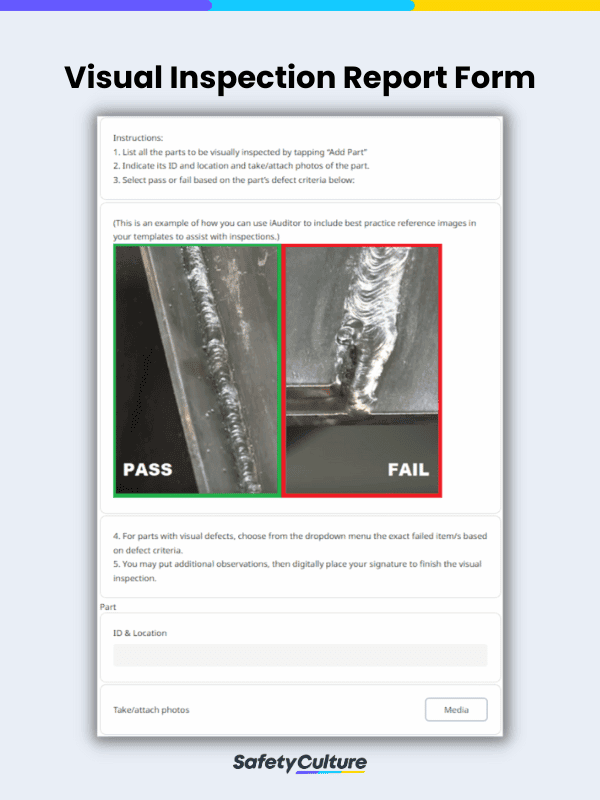What is Visual Inspection?
Visual inspection is a common quality control method of inspection that uses only the naked eye to spot defects or issues. Trained safety and quality control specialists across different industries perform visual inspections to help standardize best practices as well as reinforce compliance with safety regulations and industry standards.
How to Effectively Perform Visual Inspection
According to the British Institute of Non-Destructive Testing (BINDT), many defects are surface-breaking and can be detected by careful direct visual inspection. In some cases, quality assurance inspectors come up with inconsistent visual inspection results because they either do not completely understand defect specifications or have no references to compare the product with.
As one of the easiest and most cost-effective non-destructive testing and quality assurance methods, visual inspection procedures vary per industry. Generally, here are 5 simple steps to effectively perform visual inspections:
Step #1 Clearly define defect criteria
Key stakeholders such as quality engineers, production personnel, and customers should reach a consensus on defect specifications. Clearly defined defect criteria enable inspectors to accurately make pass/fail decisions for products. Document the defects with example photographs and technical descriptions for daily visual inspections on the shop floor.
Step #2 Standardize inspection performance
Quality managers should regularly assess the performance of the current inspection process to confirm the consistency of inspectors’ pass/fail decisions. Determine how well the inspectors’ decisions match the established defect criteria to standardize visual inspection performance in the organization. Occasionally, inspectors misinterpret the standard when they lack visual representations of the defects during visual inspections.
Step #3 Analyze visual defects
When inspectors’ decisions on the same products contradict across visual inspections, address the issue by analyzing the most significant visual defects. Evaluate the cost of quality by frequency and defect count to identify which defect type has the greatest impact on daily operations. Quality managers should also consider the cost, time to repair, and importance to the customer to create and implement effective action plans.
Step #4 Communicate improvement measures
After solving issues for specific visual defects, reassess the inspection performance to affirm overall agreement between the inspectors’ decisions and set standards. Objectively convey the results to all safety and quality personnel for accountability and ownership of continuous improvement efforts.
Step #5 Use mobile-ready checklists
Inspectors and quality managers should use mobile-ready visual inspection checklists to increase the overall throughput of quality products by more than 200%.
When inspectors can access the defect criteria anytime, anywhere, and capture photo evidence of visual defects, the accuracy of pass/fail decisions can be radically improved. When quality managers gain visibility through real-time data and actionable insights, wiser business decisions can be made and operational excellence can be achieved.
What is a Visual Inspection Checklist?
A visual inspection checklist is a valuable tool for organizations to carry out comprehensive visual inspections and audits. It enables assessors to identify any defects, issues, or other observations to note during inspections. Ideally, the checklist should be customizable, as there are different kinds of products or processes to be inspected, and its contents should be relevant to the specific inspection being performed. Visual inspection checklists also facilitate the easy documentation of key information and reporting of inspection results.
What to Include
The items of a visual inspection checklist vary depending on the business needs—especially the asset, equipment, or area to be visually inspected. Generally, however, it can include a variation of the following:
- Company/site name
- Department
- Address
- Inspector/Assessor
- Data of inspection
- ID & location
- Photo/s (as proof)
- Defect criteria
- Visual defects identified
- Additional observations
- Signature of inspector
What is a Visual Inspection Software?
A visual inspection software is a digital tool that allows safety and quality assurance personnel to perform different visual inspections. Perform visual inspections on facilities, products, or structures and enjoy the convenience of performing inspections on a tablet or mobile device.
Benefits of Using Software for Visual Inspections
Visual inspection is one of the oldest and most basic inspection methods that aid in securing quality assurance. It is done by looking over a piece of equipment and using raw human senses such as vision, hearing, touch, and smell to detect flaws.
However, this method can be inconclusive due to the inconsistency of visual inspection results caused by inspectors’ lack of understanding of defect specifications or the unavailability of references to compare the product with. Here are the top 3 benefits of using SafetyCulture (formerly iAuditor) to streamline visual inspection procedures:
1. Take a snapshot of day-to-day issues
Easily identify visual defects and support your visual inspection with photo evidence. Capture photos within the app and provide notes for a more reliable and detailed visual inspection document.
2. Deliver consistency
Get everyone on the same page with SafetyCulture. Standardize inspection templates to get a consistent structure of the information you need. Use different types of responses like multiple choices, text answers, checkboxes, and more. Provide instructions and reference photos to remove the guesswork from inspections.
3. Gain better insight into your business
Translate your inspection findings into actionable insights. Get real-time visibility on your productivity, compliance, accuracy, and other data you need to level up.
FAQs About Visual Inspection
Visual inspection is a type of quality and safety assessment that does not require any specific tools or equipment as it is mostly done using the naked eye. However, it does require special training for the particular type of inspection or at least the use of checklists so inspectors know what to look for and check.
The primary things to look for during a visual inspection are defects, asset conditions that give the impression that maintenance is needed, and any potential issues that question the integrity of the product, equipment, or structure. These defects can be both obvious and non-obvious, so it is important to perform the inspection thoroughly.
Checklists can help inspectors work more efficiently and effectively by providing a clear and concise guide for conducting inspections. They improve the quality of inspection reports by providing a standardized format for documenting findings. Additionally, it can be used as a training tool to help new inspectors learn the essential tasks involved in conducting a visual inspection.



